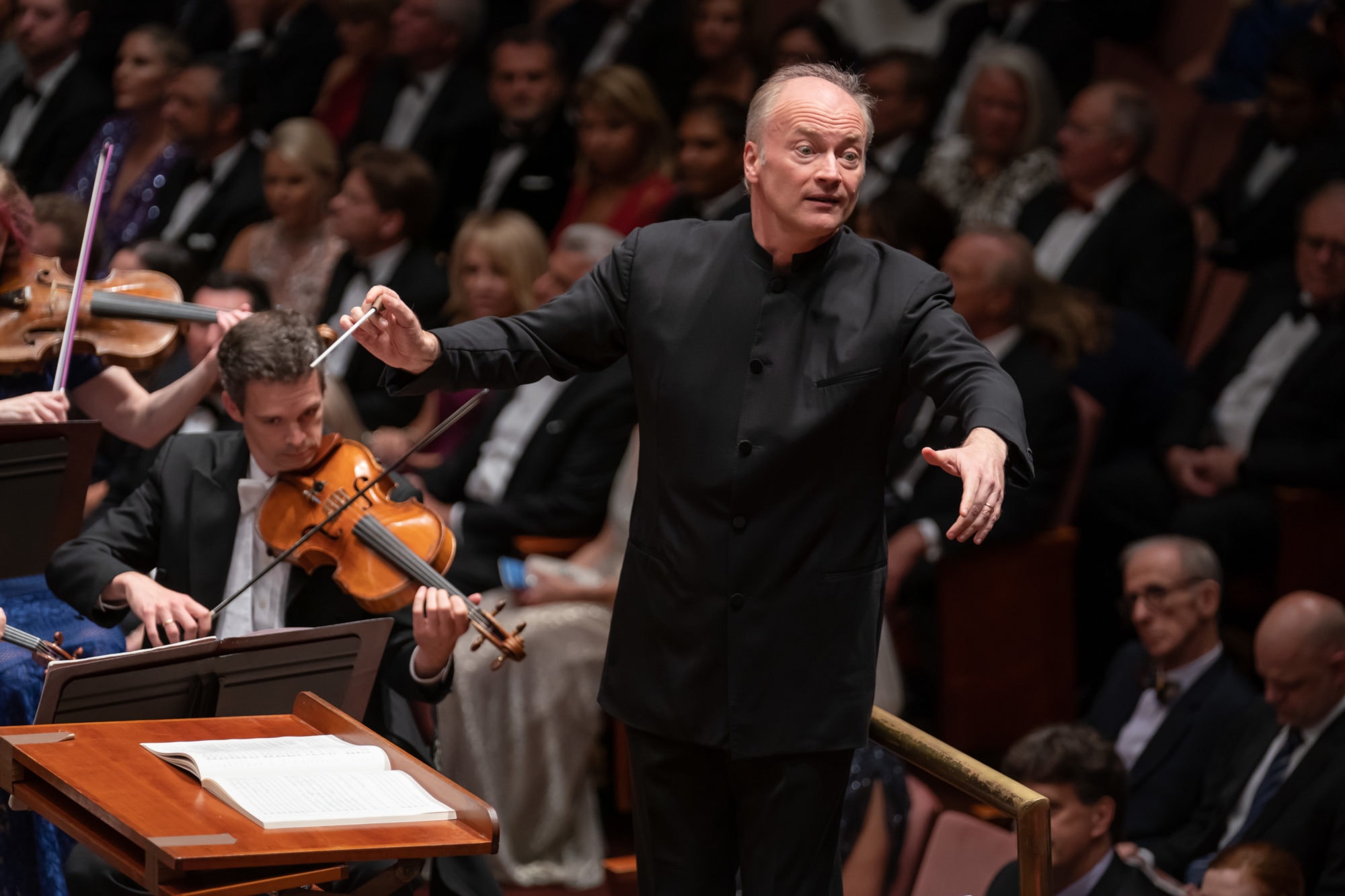The National Symphony Orchestra’s third season opener signaled a distinctively bright and cohesive sound is developing under Maestro Gianandrea Noseda.
Noseda explained to the crowd that his selections for the gala performance emphasized 20th Century musical frivolity. “A little fresh air and lightness” is how he described his selection of works by composers, none of whom were French, but all of whose works in some way reference the Jazz Age in Paris, the City of Light. Yet, it was the last-minute programming swap of Shostakovich’s first piano concerto for the composer’s weirder second one that demonstrated Noseda’s determination to find the light in whatever he conducts.

After the NSO’s players, which included women dressed in elegant and vibrantly colored gowns, sitting alongside their tuxedo-tailed male counterparts, gave their enthusiastic rendition of The Star-Spangled Banner, the evening was underway with Bernstein’s Divertimento. Commissioned by the Boston Symphony Orchestra to mark its centenary, Bernstein composed this infrequently performed collection of eight bagatelles in 1980, a year when he was supposed to have been on sabbatical writing more serious works.
The score is rife with inside musical jokes Bernstein intended for the Boston players, but minus that context, the work still filled Noseda’s bill for yester-year music that sounds fun. Although at times “forte” in the score felt more like being shouted at, the NSO players had no trouble conveying Bernstein’s merry, jazz-inflected tone. The string section’s sweet handling of the Divertimento’s Waltz was an assurance that last season’s improved string sound has been sustained, indicating the potential for it to develop into a hallmark for Noseda and the orchestra.
Before moving on to the other jocular works on the program, including Stravinsky’s Circus Polka and Scherzo a la Russe, Shostakovich’s Suite for Jazz Orchestra, and Gershwin’s An American in Paris, the fun was halted for an athletic performance of Shostakovich’s Piano Concerto No. 2 in F major. Noseda had originally chosen the composer’s jazzier first piano concerto, but a reported hand injury led Wang to ask only days before of the maestro to allow her to play the second instead.
As do many critics, I have a love-hate relationship with Shostakovich. In my estimation, the whole of his work sounds berserk, composing as he did under the Soviet Stalin regime with its state-sanctioned definitions of truth and beauty, and a suspicion of all Western music but Beethoven’s. I find his second piano concerto, composed in 1957, to be the kind of deranged work one might expect from a composer who literally feared for his life when his opera Lady Macbeth of the Mtsensk District, written in 1934, was derided by Stalin and immediately purged from the public. Yet, a body of work demonstrating how an otherwise musical genius can come to sound like a tortured paranoiac under an authoritarian regime is important to the canon, perhaps more than ever in my lifetime, anyway.
Wang, dressed in a form-fitting red gown, resembled an Olympic gymnast more than a concert pianist. She employed all her strength to successfully tackle the piece, revealing that the best way to perform Shostakovich’s musical Brutalism is to wrestle it to the ground. Initially, this muscular approach interfered with the “Andante”, but Wang relaxed mid-way through, coaxing forth the gentleness Shostakovich likely intended for his son Maxim, for whom the work was composed as a 19th birthday gift. I suspected Wang’s defter touch was due to her tuning in to Noseda’s calm control of the orchestra. Together, the maestro and his musicians managed to keep a work that even when well-executed sounds dangerously close to derailment, from running off the tracks. Wang’s pyrotechnics wowed the house, stuffed with big dollar patrons who erupted into cheers and a standing ovation storm of applause.
The NSO’s sleek precision of this work in particular was evidence of Noseda’s talent for finding the silver lining in a score without overstating his innate sense of optimism, which in works by composers such as Shostakovich, would sound patently false. Now that the maestro has hired 16 musicians – nearly a sixth of the entire corps – I am intrigued to think that during Noseda’s tenure such a practical but sunny sound might come to be how the NSO distinguishes itself.
Because it is more accessible and less chaotic, Shostakovich’s Suite for Jazz Orchestra, composed in 1934, was a pleasant palette cleanse midway between the absurd silliness of the Stravinsky selections and the Gershwin. Noseda’s bouncy direction betrayed his own delight in Stravinsky’s Circus Polka, written in 1942 for Balanchine’s ballet featuring 50 Ringling Bros. and Barnum and Bailey circus elephants. The “Scherzo” also provided the maestro an opportunity to dance to the music as he conducted.
In the NSO’s rendering of An American in Paris, I was surprised to hear subtleties from the percussion and timpani I have missed in previous performances by other orchestras. Perhaps it is further proof that a distinct sound is emerging from the Kennedy Center’s house band.
During a break in the performance, Kennedy Center Board of Trustees Chairman David M. Rubenstein announced that benefactors had helped the NSO raise 1.5 million dollars and called attention to celebrity guests in attendance, including Supreme Court Justices Samuel Alito and Ruth Bader Ginsberg, the latter of whom unequivocally received the evening’s most enthusiastic standing ovation and loudest round of cheers and applause which would not die down until the justice stood and waved to the crowd.
Running time: approx. 90 minutes
The National Symphony Orchestra Season Opening Gala played on Saturday, September 28, 2019, at the Kennedy Center – 2700 F Street, NW, in Washington, DC. For tickets to future events, go online.




